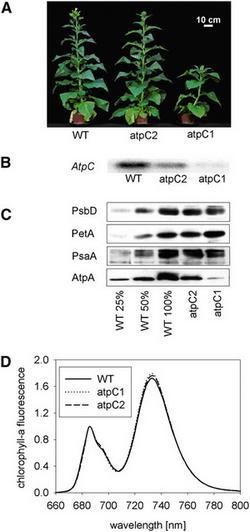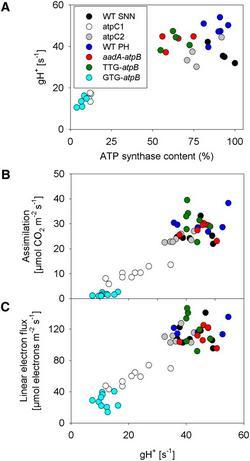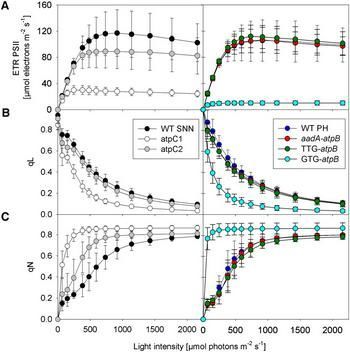Recently, German and American scientists published the latest research results online in the top international journal "Plant Cell" using differential absorption, chlorophyll fluorescence and gas exchange measurement technology. The research used molecular biology techniques to construct mutants, then combined with document.write () advanced gas exchange measurement system GFS-3000 document.write (), document.write () dual-channel PAM-100 measurement system Dual-PAM-100document.write (), And document.write () dynamic LED array differential absorption spectrometer KLAS-100 document.write () and other cutting-edge photosynthetic physiology research equipment, photoreaction to mutant photosynthesis, dark reaction, electron transfer, transmembrane proton dynamic potential , The activity of the electron mediator has been directly and comprehensively measured and analyzed. Provide reliable direct evidence support for the research results, and published in the international top journal "Plant Cell". This research represents the latest research trend of photosynthetic physiology, and it has a good reference and inspiration.
Research summary: Tobacco can strictly control the amount of ATPase and document.write (b6f complex according to the needs of synthesizing ATP and NADPH. Although the cytochrome b6f complex can regulate the photocontracting process through a rate-limiting step that catalyzes the transfer of photosynthetic electrons, The significance and role of the equally important ATP enzyme in the process of photosynthesis regulation is not yet clear. This study respectively used antisense transgene technology to inhibit the synthesis of the γ subunit (AtpC) encoded by the nucleus, and at the same time, through the chloroplast transgene technology to the atpB gene in the chloroplast The start codon encoding β subunit) is subjected to point mutation to inhibit the synthesis of ATPase. The content of ATPase in the transgenic plants obtained by the two strategies can be reduced to 100 to <10% of the wild type. The results show that although the electron transport chain The composition of the compound has not changed much, but due to the reduction of the reoxidation rate of the plastid quinone at the cytochrome b6f complex (photosynthetic regulation), linear electron transport is severely inhibited. In addition, non-photochemical quenching is very low It is excited at light intensity, which greatly reduces the quantum efficiency of CO2 assimilation. The study found that the reason is that the dynamic potential of the transmembrane proton under steady state increases, resulting in Overacidification balloon cavity, thereby inducing a regulation of photosynthesis and excitation energy dissipation of the antenna, resulting in a decrease in photosynthesis.
Main instruments used in the study (click the link to view detailed information):
Photosynthetic gas exchange and chlorophyll fluorescence simultaneous determination: GFS-3000 + 3055FL fluorescence accessory
Proton dynamic potential pmf determination: KLAS-100
Chlorophyll fluorescence, PSI differential absorption and PC determination: Standard version Dual-PAM-100 and special version DUAL-PAM (simultaneous measurement of PC and P700)
References :) The amount of cytochrome b6f complex. Although the cytochrome b6f complex can regulate the process of photosynthesis through a rate-limiting step that catalyzes the transfer of photosynthetic electrons, the significance and role of the equally important ATPase in the process of photosynthesis regulation is not yet clear. In this study, antisense transgene technology was used to inhibit the synthesis of the γ subunit (AtpC) encoded by the nucleus. At the same time, chloroplast transgene technology was used to point-mutate the start codon of the atpB gene (encoding β subunit) in the chloroplast to inhibit ATPase synthesis. The ATPase content of the transgenic plants obtained by the two strategies can be reduced to 100 to <10% of the wild type. The results showed that although the composition of the electron transport chain did not change much, linear electron transport was severely inhibited due to the decrease in the rate of reoxidation (photosynthetic regulation) of plastid quinone at the cytochrome b6f complex. In addition, non-photochemical quenching is excited at very low light intensity, which greatly reduces the quantum efficiency of CO2 assimilation. The study found that the reason is that the transmembrane proton dynamic potential increased at steady state, which caused excessive acidification of the thylakoid cavity, which induced photosynthesis regulation and excitation energy dissipation at the antenna, which ultimately led to a decline in photosynthesis.
Main instruments used in the study (click the link to view detailed information):
Photosynthetic gas exchange and chlorophyll fluorescence simultaneous determination: GFS-3000 + 3055FL fluorescence accessory
Proton dynamic potential pmf determination: KLAS-100
Chlorophyll fluorescence, PSI differential absorption and PC determination: Standard version Dual-PAM-100 and special version DUAL-PAM (simultaneous measurement of PC and P700)
References: http: // ()
Figure 1. ATPase content of AtpC antisense plants decreased and development was delayed.
(A) Wild-type (WT), weak (atpC2) and strong (atpC1) antisense strains
(B) RNA gel band, showing that the plant phenotype is related to the degree of inhibition of AtpC mRNA.
(C) AtpC antisense plant protein gel bands. For relative comparison, wild-type 25 and 50% diluted samples, wild-type samples, and weak and strong antisense plant samples are listed in order. PSII core subunit (PsbD), cyt-bf (PetA), PSI (PsaA) and ATPase (AtpA).
(D) 77K chlorophyll a fluorescence emission spectrum, indicating that the antenna structure of the transgenic plant has not changed.
Figure 4. Assimilation capacity and linear electron transfer are limited by ATPase activity
(A) Relationship between ATPase activity (gH +) and ATPase content
(B) Relationship between assimilation rate (based on unit leaf area) and ATPase activity (gH +)
(C) Linear electron transfer (based on unit leaf area. Obtained by chlorophyll a fluorescence analysis and corrected by leaf absorption coefficient.) Relationship with ATPase activity (gH +)
Figure 5. Decrease in ATPase content causes steady-state thylakoid transmembrane PMF to increase
(A) The response of the total thylakoid transmembrane pmf to different light intensities is obtained from the maximum amplitude (ECST) of the ECS signal during light-dark transition.
(B) The response of Pmf components ΔpH and ΔΨ to different light intensities. According to the ratio of ECS through the thylakoid membrane in the slow pre-kinetics (ECSinv), it is related to ECST. In GTG-atpB and antisense strains, the total pmf increased significantly, especially at low light intensity. The ΔpH component of pmf decreased slightly.
Figure 6. Decreased linear electron transfer rate, excessive reduction on the PSII receptor side, and accelerated decrease in ATPase induce an increase in qN.
(A) The light saturation curve of linear electron transfer is measured by PSII yield and corrected by the blade absorption coefficient. The decrease in ATPase content severely inhibited linear electron transport.
(B) Redox state (qL) on the PSII receptor side. As the light intensity increases, the PSII receptor side gradually decreases. It should be noted that strong antisense strains and GTG-atpB exhibit this effect under low light intensity.
(C) Non-photochemical quenching (qN). Antisense strains and GTG-atpB begin to increase at lower light intensities, which leads to increased heat dissipation of excitation energy and decreased photosynthetic quantum efficiency, so light energy The utilization rate is low.
Figure 7. Linear electron transport through cyt-bf in ATPase mutants is inhibited
(A) PSI and high-energy chain light-dependent donor-side oxidation state changes with light intensity
The reduction rate of Cyt-f (B) and P700 (C) slows down, indicating that photosynthetic regulation leads to inhibition of linear electron transport











